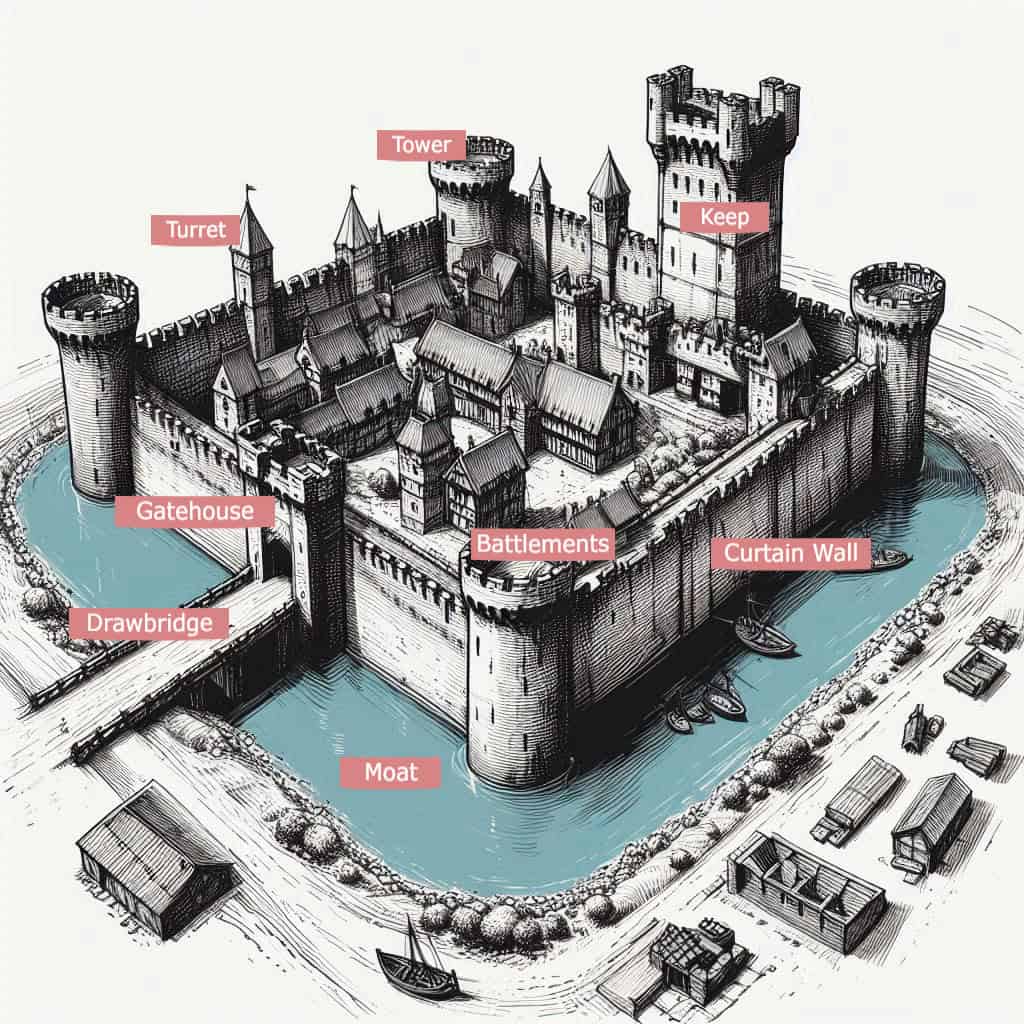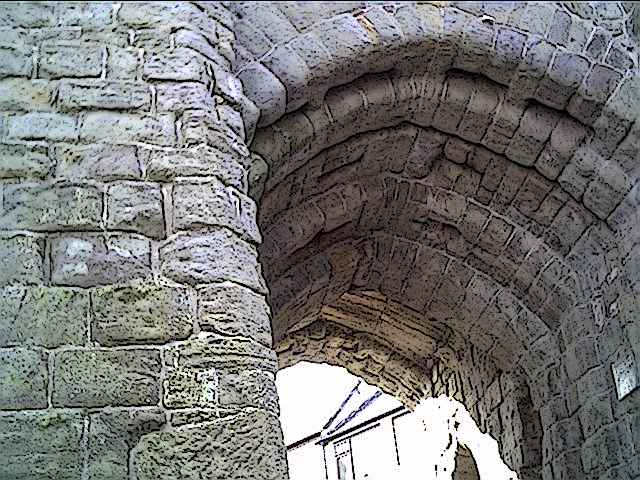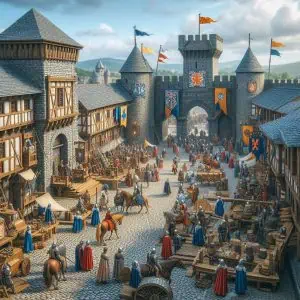
Here are some key defensive parts of a medieval castle:
Castle Walls
One of the most important parts of a castle’s defense, walls were built around the castle to keep invaders out. They were typically tall and thick, with battlements and crenelations to provide cover for archers and soldiers. Some walls even had defensive towers for added protection.

Castle Gatehouse
The gatehouse was the main entrance to the castle and was heavily fortified. It usually had a portcullis, a heavy metal gate that could be lowered quickly to prevent intruders from entering. The gatehouse also often had murder holes, small openings where defenders could drop rocks or hot liquids on attackers.

Castle Moat
A moat was a deep, wide ditch that surrounded a castle, often filled with water. It could make it difficult for attackers to approach the walls and could also serve as a barrier to ladders or siege towers.

Castle Keep
The keep was the central building of the castle and served as a residence for the lord and his family. However, it was also a last line of defense in case the rest of the castle fell. Keeps were typically tall, with thick walls and few windows, making them difficult to attack.

Castle Drawbridge
A drawbridge was a movable bridge that connected the castle’s gatehouse to the outside. It could be raised or lowered to control access to the castle.

Murder Holes
As mentioned before, murder holes were small openings in the ceiling of the gatehouse that allowed defenders to drop rocks or boiling liquids on attackers.

Barbican
This was a fortified entrance built in front of the main gatehouse, intended to delay attackers and reduce the risk of a frontal attack.
These are just a few of the key defensive parts of a medieval castle used to protect it from invaders. By combining these elements, castle builders could maximize the castle’s ability to withstand attacks and keep their inhabitants safe.

How Thick were Castle Walls?
Medieval castle walls varied in thickness depending on several factors such as the castle’s location, purpose, and the time period during which it was constructed. Generally, castle walls ranged between 2 to 4 meters (about 6 to 13 feet) thick. However, some might have been even thicker.

The thickness of the walls was a crucial aspect of the castle’s defense. Thick walls made it difficult for invaders to damage them and allowed defenders to hide behind them. Thick walls could also help absorb the impact of enemy projectiles, such as catapults or trebuchets, reducing their effectiveness.

In some cases, multiple layers of walls or a wall with a concrete core might have been constructed to increase its strength.
Castle walls were also designed with various features, such as buttresses, crenellations or battlements, as well as arrow-slits and other openings to allow defenders to fire on the enemy while remaining protected.
All these details were incorporated into the walls on the basis of the degree of defense required or based on the castle’s location.

Overall, castle walls were an essential component of medieval defenses, with their thickness and design varying depending on the demands of the time period, region, and intended purpose of the castle.
Castle Defensive Parts Historical Timeline
The timeline for castle defenses can vary depending on the region, the specific castle in question, and the time period during which it was constructed or renovated. However, here is a general timeline for when some of the common castle defenses were added:
Gatehouses
A gatehouse was a heavily fortified entrance to a castle or castle complex. The first gatehouses were built in the 11th and 12th centuries and became a common feature of castles by the 13th century.

Moats
The use of moats as a castle defense began in the 12th century when castle builders first started to dig ditches or divert rivers around the castle walls. By the 13th century, moats were a standard feature of most castles.

Keeps
The word “keep” is derived from the Middle English word “kep,” meaning “to guard or protect.” Keeps are the central fortified towers of a castle and were often used as a last resort defense. Some of the earliest keeps were built in the 10th century, but they became widespread in the 12th and 13th centuries.

Drawbridges
Drawbridges were used to span the moat or ditch surrounding the castle walls. They allowed the castle’s occupants to control access to the castle while also providing a means of escape in the event of an attack. Drawbridges first appeared in the 12th century and became a standard feature by the 13th century.

Murder Holes
Murder holes were openings in the ceiling of a gateway or passage through which defenders could drop rocks or pour boiling oil or water onto attackers. The first murder holes were used in the 13th century, but the feature became more widespread in the 14th and 15th centuries.

Barbicans
A barbican is a fortified outpost or gateway that defends a castle’s main gate. The use of barbicans began in the 13th century and became more widespread in the 14th century.
Overall, the evolution of castle wall defenses was a gradual process that took place over several centuries, with some features appearing earlier than others.
The earliest castle builders focused on constructing strong walls, towers, and keeps, while later castle builders incorporated more advanced defenses such as moats, gatehouses, and drawbridges.

What were the Most Important Defensive Parts of a Castle
based on historical research, here are the top 5 defensive parts of a medieval castle, in no particular order:
1. Walls and Towers
Thick and high walls with towers were the primary defense for a castle. They created a formidable obstacle for an enemy to overcome, as well as giving archers and other defenders a high vantage point to fire from.

2. Moat
A moat was not just a water-filled ditch, it could be very wide, very deep and incredibly treacherous. It created an additional barrier to attackers and made it difficult to dig tunnels under the walls.

3. Keep
A fortified tower, the keep was the last refuge of the castle’s defenders. A keep usually had thick walls, few windows, and a single entry point, making it almost impossible to penetrate.

4. Gatehouse and Drawbridge
If the walls and towers were breached, the gatehouse was the point of access into the castle. It was protected by a drawbridge and portcullis, which could be quickly raised in case of an attack.

5. Defensive Fighting Positions
These were areas that afforded defenders ample protection where they could fight off enemy attacks. Examples include murder holes, arrow slits, and machicolations. They allowed defenders to rain down arrows, boiling liquids, and rocks on attackers.

It is worth noting that a castle’s defense would also include its location, such as being atop a rocky cliff or hill, as well as its ability to withstand a siege, including stockpiles of weapons, food, and water. Additionally, the presence of a strong and loyal fighting force was crucial to the success of a castle’s defense.
What were the main defensive features of a medieval castle?
Medieval castles had several strong defensive features, including thick stone walls, moats, drawbridges, gatehouses, and battlements. These elements worked together to protect the castle from attacks.
How did moats help defend a medieval castle?
Moats were deep, wide ditches filled with water that surrounded the castle. They made it difficult for attackers to approach the walls with siege equipment or ladders, and often worked with drawbridges to control access.
Why were castle walls so effective in defense?
Castle walls were built tall and thick using stone, making them extremely hard to breach. Many walls had arrow slits and walkways that allowed defenders to attack invaders while staying protected.
What was the purpose of a gatehouse in castle defense?
The gatehouse guarded the main entrance and was often the most heavily fortified part of a castle. It included portcullises, murder holes, and multiple doors to trap and attack intruders trying to force their way in.
How did battlements protect castle defenders?
Battlements were the notched parapets on top of castle walls. Defenders could hide behind the raised sections and fire arrows or drop stones through the gaps, giving them both cover and clear lines of attack.
What were murder holes in a medieval castle?
Murder holes were openings in the ceiling of gate passages or towers. Defenders used them to drop rocks, boiling water, or oil on enemies attempting to break through gates or doors.
Why were towers important for castle defense?
Towers provided elevated vantage points for spotting enemies from a distance. They also allowed archers to fire at attackers from multiple angles and added structural strength to the surrounding walls.






